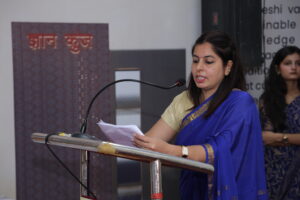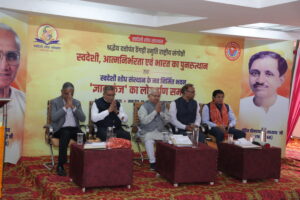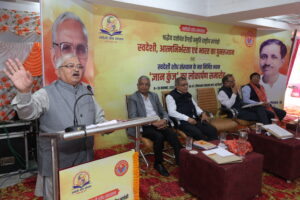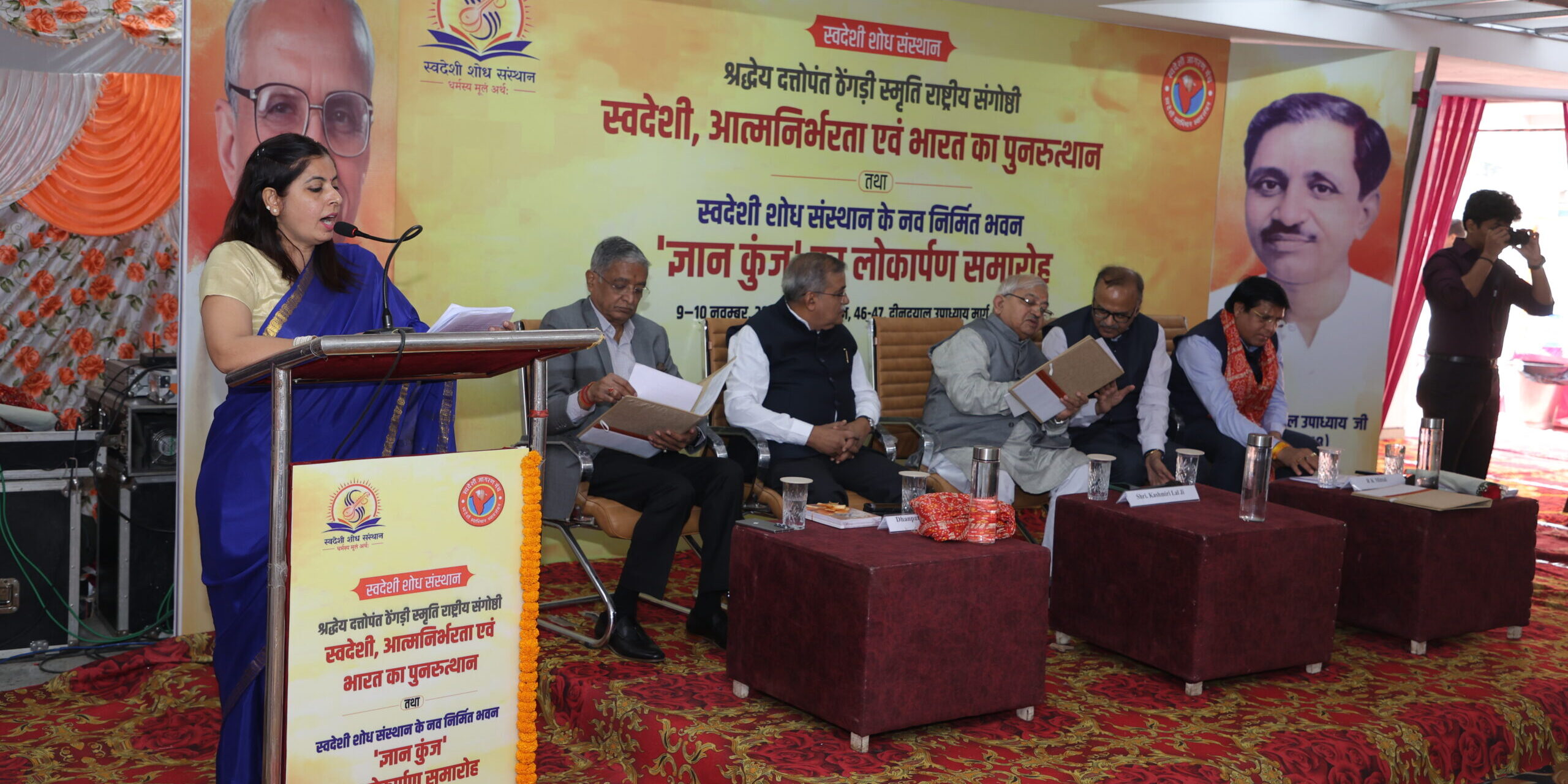Shradheya Dattopant Thengdi Commemorative National Seminar
Session 2 Report
Theme: Prosperous & Great Bharat @ 2047
Theme: Prosperous and Great Bharat @ 2047
Date: November 9, 2025
Time: 12:00 PM
Venue: Gyan Kunj, New Delhi
 Session Incharge: Dr. Ashish and Dr. Himani
Session Incharge: Dr. Ashish and Dr. Himani
Speakers: Rajkumar Chaturvedi, Prof. R.K. Mittal, Dr. Dhanpat Ram Aggarwal, Dr. Yogesh Mehta, Naresh Kumar, and Shri Kashmiri Lal ji
The second session of the Shradheya Dattopant Thengdi Commemorative National Seminar commenced at noon under the theme Prosperous and Great Bharat @ 2047. The session sought to envision India’s pathway toward becoming an economically vibrant, socially inclusive, and morally grounded nation by the centenary of independence. The proceedings were initiated by Dr. Ashish, who welcomed all distinguished panelists and contextualized the session within Thengdi ji’s vision of integral human development. He emphasized that achieving a prosperous India requires aligning national growth with ethical governance, social responsibility, and technological innovation.
Following his address, Dr. Himani began the session with an invocation of the Gayatri Mantra, setting an elevated spiritual tone for the deliberations. She greeted the audience with “Sarvebhyo Namo Namah” and introduced the panel of experts, including eminent academicians, industry practitioners, and policy thinkers. Her remarks underscored the importance of combining knowledge, innovation, and discipline to realize the dream of “Viksit Bharat @ 2047.”
Prof. R.K. Mittal: NEP 2020 – The Epitome of Resurgent Bharat
 Dr. R.K. Mittal, Director of IIT, opened the dialogue with an in-depth exposition on how National Education Policy 2020 serves as a cornerstone for India’s resurgence. He argued that the policy embodies the true spirit of Aatmanirbhar Bharat by integrating modern skill development with ethical and cultural education. Highlighting India’s demographic advantage, he called the youth the “engine of transformation,” emphasizing their role in making Bharat a thirty-trillion-dollar economy by 2047.
Dr. R.K. Mittal, Director of IIT, opened the dialogue with an in-depth exposition on how National Education Policy 2020 serves as a cornerstone for India’s resurgence. He argued that the policy embodies the true spirit of Aatmanirbhar Bharat by integrating modern skill development with ethical and cultural education. Highlighting India’s demographic advantage, he called the youth the “engine of transformation,” emphasizing their role in making Bharat a thirty-trillion-dollar economy by 2047.
Prof. Mittal underscored the need to alleviate poverty and unemployment, reduce income inequality, and ensure inclusive growth by empowering women and marginalized communities. Sustainability, he stressed, must remain central to development, as true progress cannot come at the cost of ecological balance.
Discussing the framework of NEP 2020, Mittal elaborated on vocational training, multidisciplinary learning, and digitalization as key drivers of employability. He pointed out that while India’s vocational education rate is only 5 percent, the policy aims to raise it to 50 percent. He compared this with South Korea’s model, showing how targeted skill-building leads to faster industrial growth. He also highlighted government initiatives, including the establishment of the National Research Foundation with a budget of ₹5000 crore, to strengthen research and innovation.
He called for active public-private partnerships and wider integration of educational institutions with industries. “Developed India is like hardware, and NEP acts as its software,” he remarked, concluding with an appeal to “be Vocal for Local” and cultivate self-confidence rooted in India’s cultural values.
Dr. Dhanpat Ram Agarwal: Research, Innovation, and IPR as Economic Pillars
 The next speaker, Dr. Dhanpat Ram Agarwal, a noted economist and IPR specialist, focused on the triad of research, innovation, and intellectual property as drivers of the knowledge economy. He reminded the audience that while India constitutes 18 percent of the world’s population, its share in global GDP stands below 4 percent, signaling a pressing need to accelerate innovation-based economic activities.
The next speaker, Dr. Dhanpat Ram Agarwal, a noted economist and IPR specialist, focused on the triad of research, innovation, and intellectual property as drivers of the knowledge economy. He reminded the audience that while India constitutes 18 percent of the world’s population, its share in global GDP stands below 4 percent, signaling a pressing need to accelerate innovation-based economic activities.
Quoting global statistics, he noted that human resources account for 64 percent of economic growth, far surpassing natural and capital resources. He compared India’s research investment with other countries, USA allocates 2.5 percent of GDP and China 2.6 percent, whereas India invests only 0.7 percent. This, he asserted, explains the lag in patent filings and the relatively low visibility of Indian inventions at the global level.
Dr. Agarwal outlined a holistic strategy: expanding R&D infrastructure, promoting patent awareness, enforcing intellectual property rights, and bridging the gap between academia and Industry. Encouraging young researchers to focus on invention rather than imitation, he argued that developing indigenous technology and strengthening Swadeshi production would reduce imports and bolster India’s global standing. He concluded that for Bharat to achieve prosperity by 2047, knowledge creation must become the new nationalism.
Sh. Naresh Kumar: Building National Character through Employment and Duty
Naresh Kumar addressed the role of responsibility, discipline, and character in nation-building. He urged the youth to cultivate a sense of duty toward family, society, and the nation, emphasizing that progress arises from contribution, not complaint. For a thriving economy, self-employment and entrepreneurship must replace dependency-driven thinking. He proposed sending young entrepreneurs for international exposure, particularly to industrial hubs like China, to study production systems and return with implementable innovations for India. His address highlighted that economic progress ultimately stems from a moral awakening and collective accountability.
Dr. Yogesh Mehta: Challenges and Opportunities for a Great Bharat
 Industrial expert Dr. Yogesh Mehta delivered an analytical address on Opportunities and Challenges before India. He outlined India’s industrial potential and the bottlenecks impeding its full realization. Currently, India’s exports form only 45 percent of its trade volume, primarily due to outdated manufacturing technology and lack of standardization. He identified the absence of a robust Standard, Measurement, and Specification (SMS) ecosystem as a key weakness and called for a complete restructuring of quality frameworks.
Industrial expert Dr. Yogesh Mehta delivered an analytical address on Opportunities and Challenges before India. He outlined India’s industrial potential and the bottlenecks impeding its full realization. Currently, India’s exports form only 45 percent of its trade volume, primarily due to outdated manufacturing technology and lack of standardization. He identified the absence of a robust Standard, Measurement, and Specification (SMS) ecosystem as a key weakness and called for a complete restructuring of quality frameworks.
Dr. Mehta advocated quality-conscious production, investment in modern testing labs, and strong linkages between academia and industry. He urged Indian SMEs to focus on research, innovation, and the development of swadeshi brands that can compete globally. To achieve long-term competitiveness, he suggested promoting vocational training, digital literacy for industrial workers, and knowledge transfer between first and second-generation entrepreneurs. He envisioned opening Bharat Bazaars abroad as an innovative export strategy to expand the reach of indigenous products.
He concluded by affirming that India’s youth must transform from job seekers to job creators and that bridging the gap between education and enterprise will be crucial for realizing the 2047 vision.
Shri Kashmiri Lal ji: Presidential Address and Vision of Enduring Commitment
 In his inspiring presidential address, Shri Kashmiri Lal ji encapsulated the philosophical foundation of national prosperity through the timeless Sanskrit verse:
In his inspiring presidential address, Shri Kashmiri Lal ji encapsulated the philosophical foundation of national prosperity through the timeless Sanskrit verse:
“सुखस्य मूलं धर्मः। धर्मस्य मूलं अर्थः। अर्थस्य मूलं राज्यं। राज्यस्य मूलं इन्द्रिय जयः। इन्द्रियाजयस्य मूलं विनयः। विनयस्य मूलं वृद्धोपसेवा।”
He explained that the happiness of society rests on righteousness; righteousness stands on economic strength; economic strength on good governance; governance on self-control; and self-control on humility and service to elders.
Kashmiri Lal ji traced the founding journey of the Swadeshi Shodh Sansthan, recalling how the idea conceived 27 years ago has matured into a thriving institution. Using the metaphor of the bamboo plant, he described how true growth requires silent preparation, years of unseen rooting before visible progress. Similarly, the Sansthan devoted years to building intellectual and ideological infrastructure before emerging as a national thought institution.
He appreciated the contributions of all scholars and acknowledged Dr. Bhagwati Prakash Saraswati ji’s unique genealogical research tracing 109 ancestral generations as a symbol of India’s respect for continuity and heritage. In conclusion, he called upon young researchers and professionals to take responsibility for the institution’s next phase, expanding its activities, strengthening its intellectual base, and integrating economic self-reliance with cultural and moral resurgence.
Conclusion
Session 2 of the seminar offered a visionary roadmap toward Prosperous and Great Bharat @ 2047, combining practical insights with ethical guidance. Each speaker reinforced that prosperity is not merely economic advancement but a harmonious synthesis of intellectual, moral, and cultural power. The discussions spotlighted education reform through NEP 2020, innovation-led growth, the strengthening of human resources, women’s participation, and swadeshi enterprise as pillars of national progress.
Anchored by Dr. Ashish and Dr. Himani, the session reaffirmed that India’s path to greatness rests on the fusion of science and spirituality, skill and service, knowledge and nationalism. The deliberations concluded with a shared optimism that by 2047, Bharat will emerge as a self-reliant, prosperous, and dharmic global leader, fulfilling the vision of thinkers like Shradheya Dattopant Thengdi ji.






